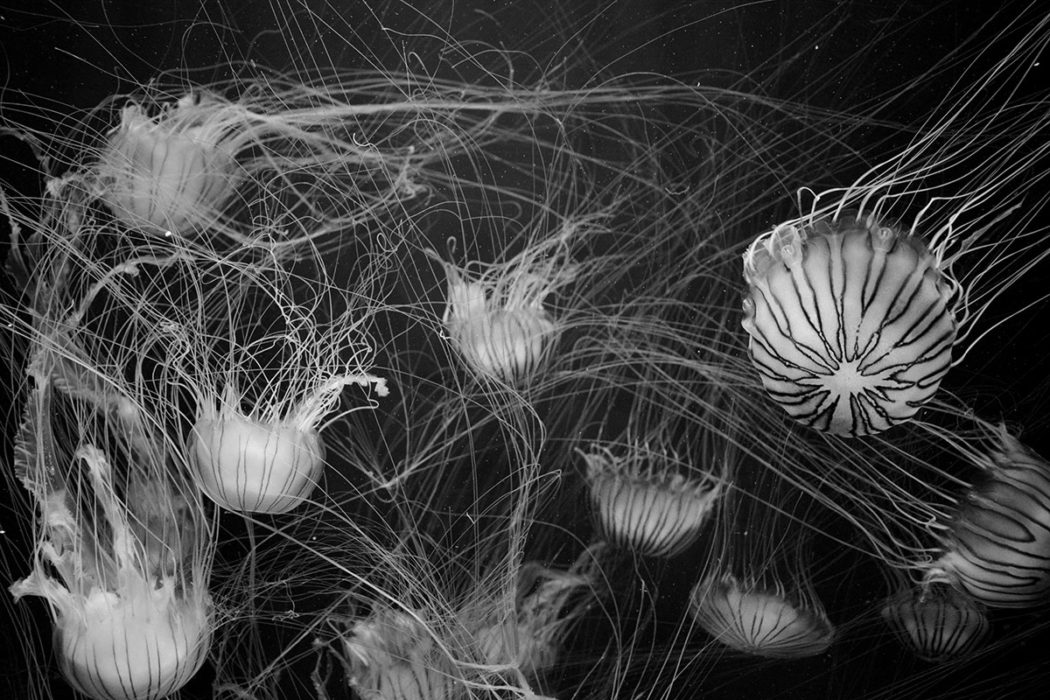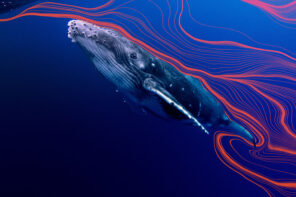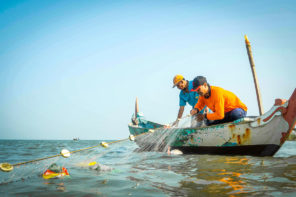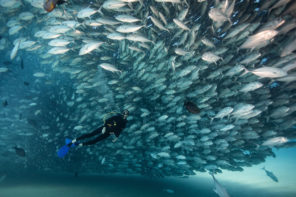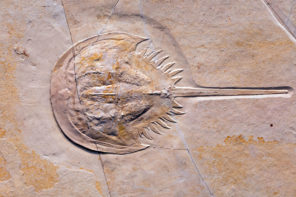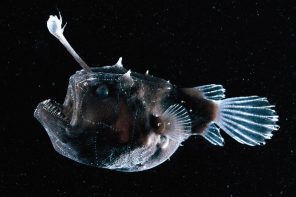Alaskan Voyage Leads Scientists to a Jellyfish Discovery
On a brisk February evening in 2019, the RV Professor Kaganovsky, a Soviet-era expedition ship, was making its way across the Gulf of Alaska. Biological oceanographer Brian Hunt walked along the deck of the vessel beneath an overcast sky, past the scientific research equipment and fishing gear that lay tied down in preparation for the twenty-foot swells that the crew anticipated. Hunt made his way to the edge of the ship, and gripped the cold railing, its rusty flakes chipping off beneath his numb hands. As he looked out across the open ocean, he noticed something big and brazen floating in the wake.
It was a trail of glowing Chrysaora melanaster, a species of jellyfish also known as the northern sea nettle.
Illuminated by the ship’s floodlights, the hoods, or medusa, of the jellies reached almost two feet in diameter. Beneath each bronzed and glowing medusa, ten-foot-long tentacles faded into the deep.
Under normal circumstances, the northern sea nettle is found much closer to shore, much further south, and in far fewer numbers. As Bill Murray was probably out somewhere aboard the SS Belafonte and unable to attend the expedition, Hunt instead decided to call over fellow biologists, oceanographers, and crew members. Aleksey Somov, of the Russian Federal Research Institute, was looking out of the porthole from his bunk into the night sky when he heard word of the bloom echoing through the passageway. He leaped out from his corridor and made haste through the mess hall, where a portrait of Vladimir Putin hung over the decades-old wooden dining tables. He then passed the washing areas, where one would be lucky to take a shower in the tarnished buckets every three days or so, given their water supply. And as Somov stepped onto the deck and observed the jellyfish, he became equally as intrigued as Hunt. These jellies were not in the right place, the two agreed.
The further north the RV Professor Kaganovsky went, the more northern sea nettle Hunt and Somov saw. Every evening, mega-swarms came into view, surrounding the ship, gleaming in the dark Arctic night.
“It was amazing. It is not something you would expect to see out in the open ocean, and it’s something that had never been documented before.”
Brian Hunt
Hunt and Somov began to brainstorm about how to best keep a record of the numbers of northern sea nettle they were seeing. Although the species was also present during the day, visibility improved exponentially in the evenings, when the ship’s lights highlighted the jellies.
“Aleksey had the idea to count from actual visual observations,” said Hunt. “To do a comparison of what we see versus what we could coordinate in a net. Jellyfish can pass through the mesh of a net quite easily, so it isn’t very effective in catching them to examine the numbers. We knew that the bloom was extensive, but this was really amplified when we took the true numbers from our visual observation.”
For 11 nights, Hunt and Somov spent their evenings on deck, counting. They estimated that each bloom consisted of some 130,000 to 240,000 jellyfish per kilometer squared.
In total, the expedition passed some 10 million tons of jellyfish.
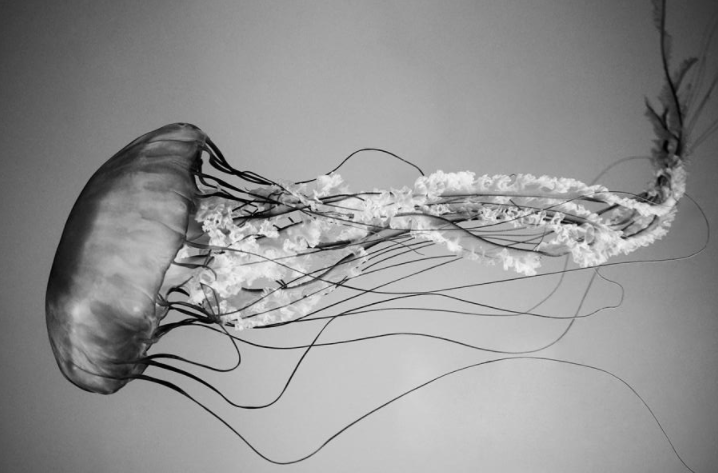
What Hunt and Somov witnessed was unusual for the Gulf of Alaska, but is becoming increasingly common across the globe; Over the course of the last decade, more and more reports of jellyfish appearing in new places, and in greater numbers have become more frequent. Within the last three years, dozens of stories of jellyfish have flooded media outlets, including news of giant, stinging lion’s mane jellyfish appearing on Massachusetts beaches, of thousands of blue jellyfish clogging Israeli power plants, and of Japan’s coastal waters being invaded by Nomura jellyfish, the world’s largest species, almost seven feet in diameter.
As the changing climate warms ocean temperatures, many organisms are being forced to make shifts in their habitat. That may mean that the populations of some fish, like salmon, and other marine creatures will continue to decline in population. But the jellies appear to be benefiting in ways from warming oceans and a changing climate.
They are nothing if not master survivors and are on the rise.
Scientists have discovered some 200 species of jellyfish, and many of them were around before vertebrates evolved, some 450 million years ago. The earliest known jellyfish fossil, with its distinctive bell shape and tentacles imprinted into a rock found in Utah, dates back more than 540 million years; some researchers estimate that the species — the comb jelly — may have been around for 700 million years, appearing long before fish and even horseshoe crabs, and most likely living among creatures such as sponges, cyanobacteria, and velvet worms. As one of the most opportunist species, jellyfish have throughout history shown an ability to both adapt to as well as thrive in environments and degraded ecosystems in which other species cannot. They are one of the only species to have survived every mass extinction in Earth’s history.
Much of the current research on jellyfish is focused on how climate change is benefiting them, by giving them warmer, more acidic seas in which they can thrive. “There is a general feeling that jellyfish are increasing worldwide,” said Richard Brodeur, a National Oceanic and Atmospheric Administration research fishery biologist. Brodeur was one of the first to review the growing evidence of jellyfish shifts more than a decade ago, after he noticed tropical jellies moving further north in the Pacific Ocean. He noted that jellyfish favor the conditions that climate change is bringing: warmer waters, and changing water chemistry, specifically ocean acidification.
Researchers have also noted that marine pollution is abetting the jellies’ expansion. Jellyfish asexually produce tiny larvae, which settle to the ocean floor for their polyp phase. Although the young jellies need a surface to perch on where they can grow, and many typically use the sea bed in the shallows, man-made surfaces such as plastics, boats, and docks now provide a substrate to attach to. As a result, species such as the northern sea nettle are now able to thrive in deeper water, expanding their populations and range.
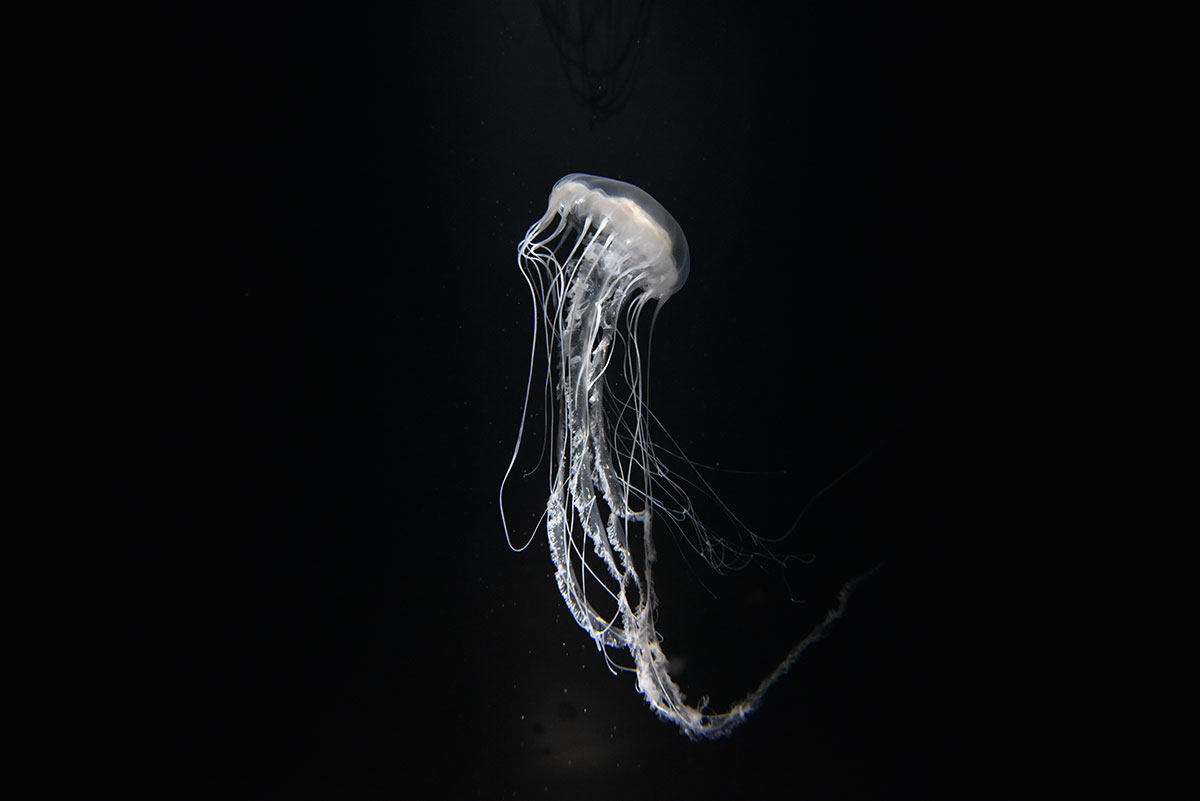
As overfishing continues to perpetuate the seas, jellyfish have much more agency to move up into any eco-space, outcompeting the fish. As more pollution rolls into the oceans, it affects the fish and provides jellyfish with polyp-growth grounds. As more coastal construction is built, there is furthermore room for jellyfish polyps to settle. As more jellyfish bloom, more become caught in fishing nets and power plants across the world — thus becoming a “perfect weed” of sorts, a pesticide that has come to thrive in an environment in which other species will cease to have the ability to live in.
As jellyfish habitats and numbers have grown, researchers from other fields have begun to study the organisms as well. In particular, Brodeur said, scientists are looking more at jellies’ impacts on commercial fisheries. He has observed declines in northern anchovy and sardine populations and Pacific sardines that he attributed, in part, to jellyfish outcompeting the fish for zooplankton. “Government labs, which have had to focus on commercially important species due to funding restrictions, have recently started to look at jellies as they have been increasing in many ecosystems around the world, with negative implications for fish of interest to humans,” said Brodeur.
Man-made surfaces such as plastics, boats, and docks now provide a substrate to attach to. As a result, species such as the northern sea nettle are now able to thrive in deeper water, expanding their populations and range.
Hunt and Somov, both fisheries biologists, fit into that category. They were on the Rv Professor Kaganovsky to investigate salmon and ended up also studying jellies.
Ocean acidification is already affecting organisms like oysters and corals, and as it continues to increase, organisms that rely on the ability to maintain their shells, skeletons, and other calcium structures, may literally begin to dissolve. A small change in the pH of seawater has harmful effects on marine life, impacting chemical communication, reproduction, and growth. The boneless jellies, however, are still able to thrive through acidification.
And the oceans are not just facing increased acidification but increased heat intake as well. When sunlight reaches the Earth’s surface, the world’s oceans absorb some of this energy and store it as heat. Now, increasing greenhouse gasses are trapping more of this energy from the sun. Some of this warming is especially evident in certain regions. In 2013 a large body of warm seawater was observed off the coast of Oregon. It was 500 miles wide and 300 feet deep, and 4.5 degrees Fahrenheit higher than what was usual for the time of year. The discrepancy in temperature caused significant ecosystem disruption, as warmer temperatures cause the sea to lose nutrient-richness. By 2016, this warm weather system known as “The Blob” had expanded to cover more than 2,000 miles.
According to Hunt, the phenomenon created a feedback loop, which allows the size of the area to keep growing. “Wind is very important in the ocean because it causes mixing, pushing water around to regulate the temperature,” said Hunt. “The warmer surface water gets mixed with the deep water and changes the water properties. The Blob slowed the mixing, and caused more heat potential on the surface, which kept building —and that’s why ocean temperatures increased.”
According to Kristin Cieciel, a research biologist at the National Oceanic and Atmospheric Administration, The Blob is providing Pacific jellyfish, like the northern sea nettle, with greater range. The observation in the Gulf has made many researchers concerned about their impacts on salmon, one of the main fisheries in the region and one that is being affected by warming waters and climate change.
If we choose to vilify the jellyfish, we’re missing the whole point. They can’t defend themselves, they’re brainless!
Lisa-Ann Gershwin
The abundance of jellies makes life more difficult for salmon and other fish. Like salmon, jellyfish mainly feed on zooplankton, and their large blooms in predominantly salmon populated waters mean higher competition for food. “At that point, the food isn’t available when the adolescent salmon get out there,” said Cieciel. “Predation pressure is then also increased, because as the warmer water allows species like jellyfish to come up further north, they may bring with them sea turtles and larger fish, who feed on salmon.”
“Effects like The Blob literally removed our ability to predict what should normally occur,” said Cieciel, who has worked as a fisheries biologist in Alaska for more than 17 years, and predicts that there may not be room for wild fisheries in the future.
Biologist and author, Lisa-Ann Gershwin, notes that jellyfish have survived every major extinction event in the past. Many scientists have documented that the world is currently undergoing another such event. Perhaps jellyfish, Gershwin said, will again be “the last man standing.”
“If we choose to vilify the jellyfish, we’re missing the whole point,” said Gershwin. “They can’t defend themselves, they’re brainless! If we as humans blame the jellies, we’re dismissing the role that we’re playing, and the opportunity to do something about that.”
Ever since the RV Professor Kaganovsky made its way from the high seas back to Vancouver, Hunt and Somov said they have been preoccupied with the jellies. What, they wonder, do the swarms mean about the ecological shifts in the Gulf? Will the jellies return every winter? How long until they outcompete the salmon populations? What will the fishermen, a major part of Alaskan culture and economy, do? Hunt hopes that another voyage—once field research gets the green light again—will bring more answers. “Ocean conditions are changing,” Hunt said. “The huge Chrysaora bloom is an indicator of that. We need to keep going back to understand the system better and better.”
Maybe next time, when Bill Murray can finally be on board, Hunt and Somov will be able to come even closer to finding further causes and solutions behind such a bewildering bloom.

